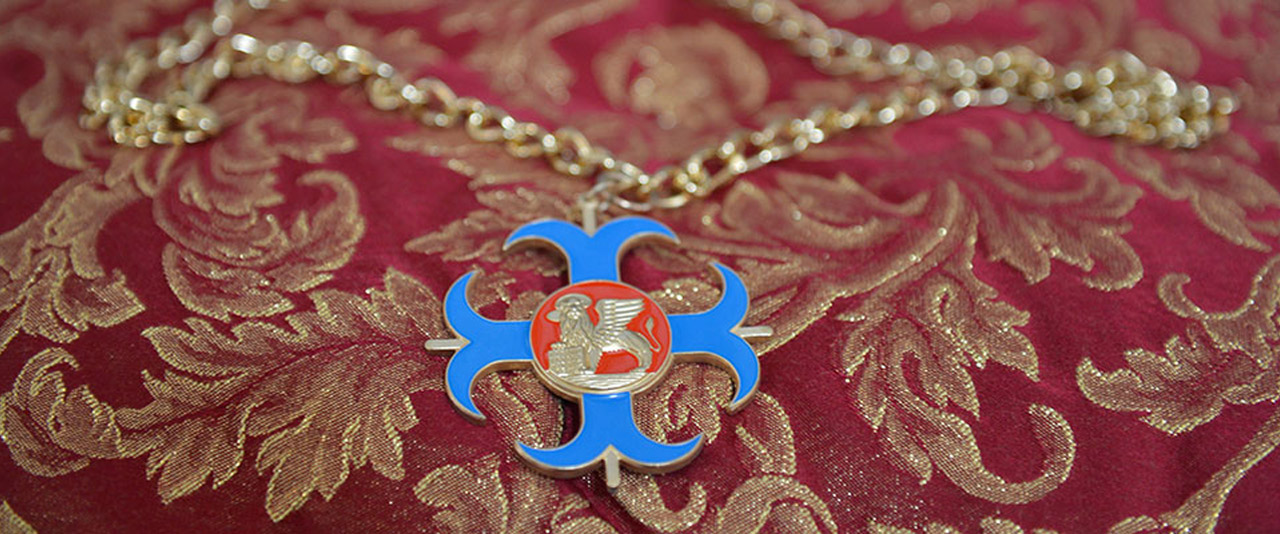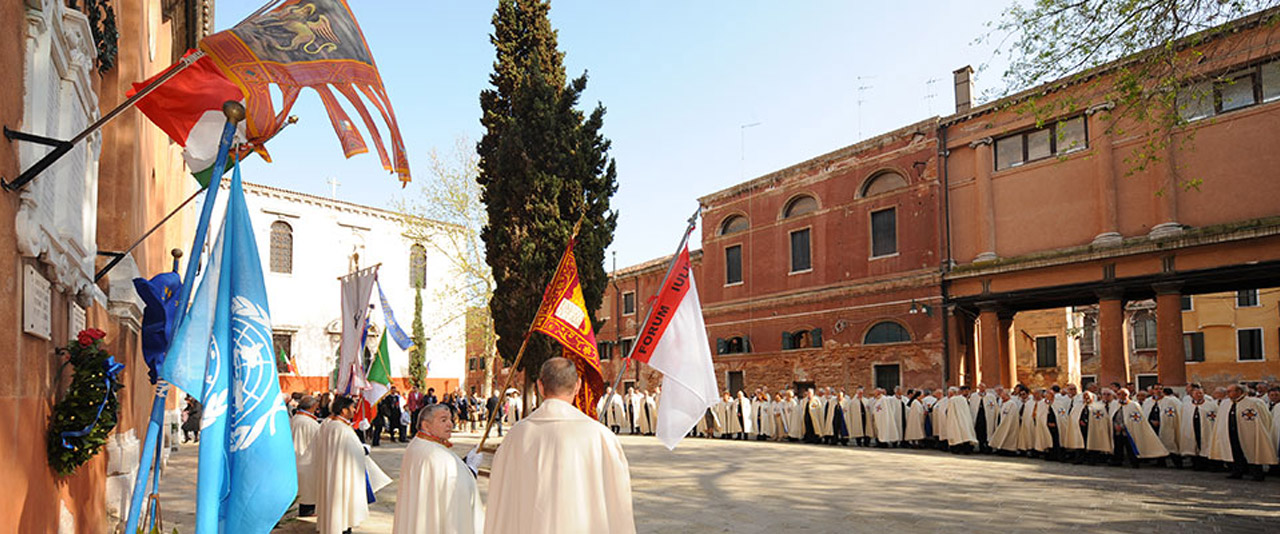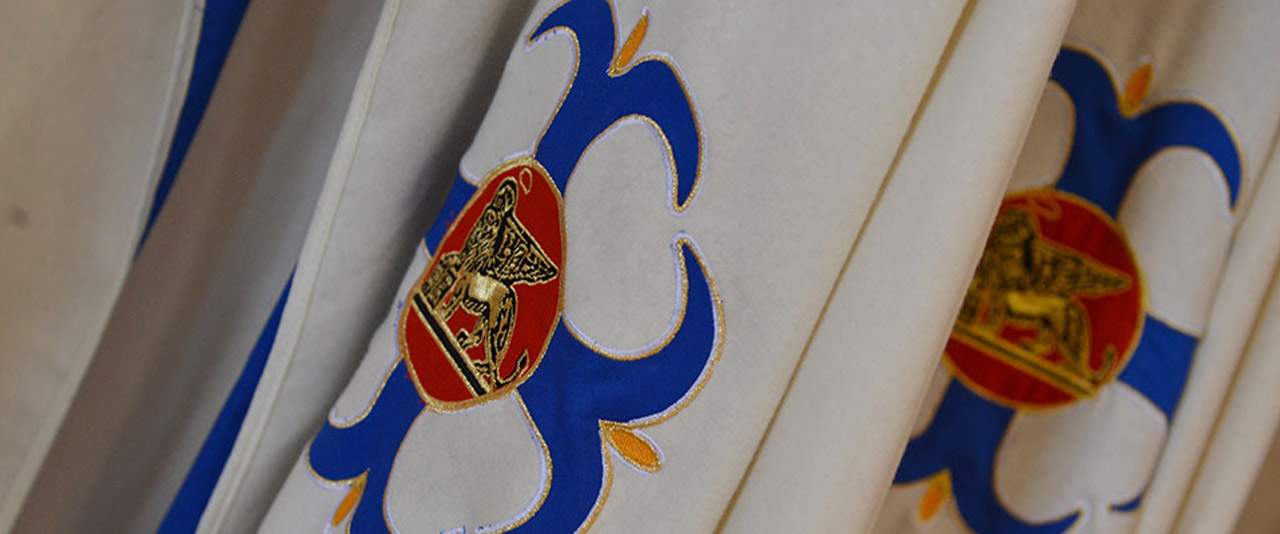History
WHO WERE THE KNIGHTS OF ST. MARK IN HISTORY?
The exact date of the foundation of the Order ofSaint Mark’s Knights remains shrouded in mystery: although scholars have demonstrated their interest by carrying out much detailed research at the Venice State Archive, they have not been able to retrace any document mentioning the event of the foundation of the Saint Mark’s Knights Equestrian Order.
Research brought to light some historical fragments that let us presume that the Order existed since ancient times, but no fact or element useful to state the date or the precise period before the investiture has been discovered.
Some of the news on the “Saint Mark’s Knights” during the Venetian government can be confirmed by consulting different publications; one that deserves special attention is reported in the Association magazine issued in December 1986 on the occasion of the celebration of the 10th anniversary of the re-foundation of the “Saint Mark’s Knights”, that says….
Not even the index of the Saint Mark’s Knights from 1456 to 1792 mentions the origin of the order; what is certain though is that the “Saint Mark’s Knight” did exist.
This is confirmed by Nicolò Contarini, who in 1847 wrote that the title of “Saint Mark’s Knight” was conferred to meritorious citizens, and also by
Ricciotti Brati, who in 1898 tried to compile a history of the “Saint Mark’s
Knights”.
In his book no foundation date is mentioned, there is only a description of the documents taken from the Correr Museum, one of them is a report of a battle that says what follows:
The 17th of April Captain Marco Jvanovich was sailing his tartan and two
bigger boats, Santissimo Crocefisso and Madonna del Rosario, towards the Peloponnese. On reaching the waters of Patras, he ran into a barbarian boat that had been following his two bigger boats covered in Venetian flags, and that pointed its bow full sail toward his tartan. Jvanovich tried to proceed as fast as he could, but when he realized that the other ship was too fast, he bravely got ready for the assault and lifted the glorious insignia of Saint Mark’s, while the enemy’s boat was carrying Tripoli’s flag.
The disparity was immediately clear.
Tripoli’s ship had 200 sailors and 16 cannons. What was the Venetian Captain meant to do with his 19 men and only 8 pieces of artillery? The battle though was unavoidable and Jvanovich, who would have preferred to die than to become a prey in the enemy’s hands, was getting ready to make the corsair pay dearly for the audacious enterprise.
A cannon ball nearly forced Jvanovich to give up, but he replied with a heavy artillery shooting that kept the enemy quite busy. The battle lasted for uninterrupted hours, the Venetian tartan rejected three assaults, until the corsair, during the dark night, with his crew and boat damaged, decided to leave.
In the Ss. Giorgio e Trifone degli Schiavoni church in Venice, there is a
painting depicting the naval battle that earned Marco Jvanovich the title of Saint Mark’s Knight, in the centre of the bottom of the painting there is a medallion with the portrait of Jvanovich himself, who shows with his hand the Knight’s cross hanging from the side of his chest.
At Museum Correr in Venice, there are two Saint Mark’s Knight crosses and a necklace with a medal of the Republic of Venice.
One has its relative fabric webbing attached, while the other has pieces of Venetian “Manin” chain, joint at the extremities by two frieze-like decorated clips.
Doge Alvise Mocenigo conferred in 1769 the eternal equestrian title to the Canons of the Treviso Cathedral, of which they still take pride today.
With a solemn ceremony held on the 6th of May 1995, Dean Vicar of the diocesan administration of Treviso, Monsignor Pietro Guarnier, in the Church of San Francesco della Vigna, handed to the, then, Mayor of Venice, Massimo Cacciari the reproduction of the original of the“Saint Mark’s Knights Cross” conferred to canons.
Without any historical doubt, the symbol of the “Saint Mark’s Knights” finally found official confirmation.



